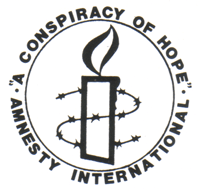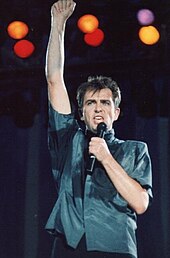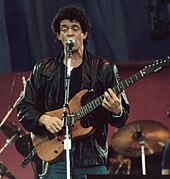A Conspiracy of Hope
| Benefit tourbyAmnesty International | |||||||||||||||||||
 | |||||||||||||||||||
| Location | United States | ||||||||||||||||||
|---|---|---|---|---|---|---|---|---|---|---|---|---|---|---|---|---|---|---|---|
| Start date | June 4, 1986 | ||||||||||||||||||
| End date | June 15, 1986 | ||||||||||||||||||
| Legs | 1 | ||||||||||||||||||
| No.of shows | 6 | ||||||||||||||||||
| Attendance | 116,116 | ||||||||||||||||||
| Box office | $4.041 million ($11.23 million in 2023 dollars) | ||||||||||||||||||
| |||||||||||||||||||
A Conspiracy of Hopewas a short tour of sixbenefit concertson behalf ofAmnesty Internationalthat took place in the United States during June 1986. The purpose of the tour was not to raise funds but rather to increase awareness of human rights and of Amnesty's work on its 25th anniversary. The shows were headlined byU2,StingandBryan Adamsand also featuredPeter Gabriel,Lou Reed,Joan Baez,andthe Neville Brothers.The last three shows featured a reunion ofthe Police.At press conferences in each city, at related media events, and through their music at the concerts themselves, the artists engaged with the public on themes of human rights and human dignity. The six concerts were the first of what subsequently became known collectively as theHuman Rights Concerts– a series of music events and tours staged byAmnesty International USAbetween 1986 and 1998.
Background
[edit]The tour was conceived by the Executive Director of Amnesty International's U.S. section,Jack Healey.The tour was run by famed concert promoterBill Graham,who served as executive producer along with Healey and Mary Daly, also of Amnesty.[1][2]James Radner was "Concerts for Freedom" manager for the tour. In developing the tour, Healey drew on his relationship withMartin Lewiswho had first recruited rock musicians such asPete Townshend,StingandPeter Gabrielto work with Amnesty several years before forThe Secret Policeman's Ball's series of benefit shows in England (1976–1981).[3][4]
Performances
[edit]| Date (1986) |
City | Country | Venue | Attendance | Gross | Ref(s) |
|---|---|---|---|---|---|---|
| June 4 | Daly City | United States | Cow Palace | 15,944 / 15,944 | $468,300 | [5] |
| June 6 | Inglewood | The Forum | 13,380 / 13,380 | $558,040 | [5] | |
| June 8 | Denver | McNichols Sports Arena | 8,368 / 11,700 | $282,880 | [6] | |
| June 11 | Atlanta | Omni Coliseum | 11,592 / 11,592 | $397,515 | [6] | |
| June 13 | Rosemont | Rosemont Horizon | 16,625 / 16,625 | $577,955 | [6] | |
| June 15 | East Rutherford | Giants Stadium | 50,207 / 50,207 | $1,757,245 | [6] | |
| TOTAL | 116,116 / 119,448 (97%) | $4,041,935 | ||||

The final show at Giants Stadium was an all-day event, running from noon until 11 p.m., at an outdoorstadiumrather than the indoorarenasused for the first five concerts. The following additional artists performed at this concert (in order):John Eddie(with guestsMax Weinbergand14 Karat Soul),Third World,the Hooters,Peter Paul & Mary,Little Steven(with guestsDarlene LoveandJohn Waite),Bob Geldof(also with guestsDarlene Love,Paul Shaffer,andJohn Waite),Stanley Jordan,Joan Armatrading,Jackson Browne,Rubén Blades(withFelaandCarlos Santana),Nona Hendryx,Yoko Ono,Howard Jones,andMiles Davis.The show then continued with the regular performers (in order) ofthe Neville Brothers,Joan Baez(Baez and the Nevilles also performed a number of songs together),Lou Reed,Peter Gabriel,Bryan Adams,Joni Mitchell(special to NJ),U2,the Police(withBonoduring the songInvisible Sun) and finally everyone came out together to perform "I Shall Be Released".
Stage introductions were made by Bill Graham, SenatorBill Bradley,Robert De Niro,Christopher Reeve,Michael J. Fox,Daryl HannahandMuhammad Ali. The show was televised in its entirety byMTV,with the final three hours syndicated on broadcast television byViacom.Westwood Oneaired the concert as a live radio broadcast. Pre-tapedpublic service announcementsabout human rights by prominent figures in the entertainment world were presented on giant video screens and during the television broadcast.

Jackson Browne had also performed at the San Francisco and Los Angeles shows. Robin Williams had performed an impromptu stand-up set at the Chicago show.MadonnaandSean PennintroducedBryan Adamsat the opening night in San Francisco.
The pioneer of rock music for Amnesty,Pete Townshend,was scheduled to perform at the Giants Stadium concert, but had to cancel at the last moment when his father,Cliff Townshend,became gravely ill, necessitating his immediate return to London. This would have been Townshend's first ever US solo appearance.
Musical themes
[edit]
The tour artists generally arranged their sets around themes of politics, freedom, and courage. Multiple performers joined U2 for Little Steven's "Sun City",while the assembled multitude sangBob Dylan's "I Shall Be Released"at the end.Bonosometimes joined the Police for theTroubles-flavored "Invisible Sun",while Fela and Santana joined the Neville Brothers as well. Some of the less rock-oriented acts lost crowd attention during the long Giants Stadium event (notably Joni Mitchell, who admonished the audience from the stage for their rowdy behavior during her set), although Baez was well received with a diverse set that included a rousing version of"The Times They Are a-Changin'",as well as Fela and the Nevilles assisting her on"Let It Be"andTears for Fears' "Shout".(Curt Smithof Tears for Fears was in the audience at the Cow Palace show, and joined Baez and the Nevilles on that show's performance of this song.)
The tour enhanced the growing stature of both Peter Gabriel and U2, who were on upswings of popularity and whose "Shock the Monkey"and"Bad"respectively showed percussive, hypnotic power in large settings.Stingwas originally slated for the tour as a solo performer with his touring band, but he reconvenedthe Policefor the final three concerts (with their first appearance, in Atlanta, being unannounced) to further assist Amnesty's fund-raising and profile-raising with the enhanced value of a Police reunion. These were the last public Police performances until theirRock and Roll Hall of Fameinduction in 2003.

Yugo,the Yugoslavian auto manufacturer was a sponsor of the final concert at Giants Stadium and supplied a car backstage at the Giants Stadium show. The car was autographed by the performers and celebrities who made on-stage announcements at the show. The vehicle's whereabouts today are unknown.
Impact
[edit]
Inevitably there were some who wondered whether attendees were understanding the message of the event or simply there for the music. APhiladelphiarock radio station sent an interviewer into the Giants Stadium concessions line, who seemed shocked to encounter an audience member who not only knew what Amnesty was but was a member.
Bono addressed the doubters and cynics in an interview inRolling Stoneshortly before the tour began in which he said that he knew first-hand the value of attending such shows: "The audience is going to be great. I know that because I was part of that audience once. I saw 'The Secret Policeman's Ball' and it became a part of me... It sowed a seed."
On Monday June 16, the morning after the final show at Giants Stadium in New Jersey, Sting, Peter Gabriel, tour promoter Bill Graham and Amnesty director Jack Healey were guests on theToday Show.HostBryant Gumbelasked, "I don’t think any of us would quibble about the worth of the cause but what leads you to believe that anybody left with anything more than a smile?"
Sting responded:
I've been a member of Amnesty for five years and a supporter because of an entertainment show which was called 'The Secret Policeman's Ball' which I was involved in. And before that I didn’t know about Amnesty's work and so in a sense I’m a success story. I know that these kind of events work. I’m sure that there were 80,000 people there last night a good proportion of them will want to be supporters and who will want to carry on the work.[7]
One month after the tour, the membership of Amnesty International in the United States had increased by 45,000 members.[8] Concert-goers had been asked to send appeals for freedom on behalf of six prisoners of conscience, two of whom were released within months after the tour.[which?]
References
[edit]
- ^David Fricke(June 19, 1986)."Amnesty International: Caravan for Human Rights".Rolling Stone(476).RetrievedMay 15,2015.
- ^Curtis, Charlotte(1986-04-15)."A Rock Effort To Support Man's Rights".The New York Times.ISSN0362-4331.Retrieved2022-07-14.
- ^Gundersen, Edna,"Big show, big impact? Live Earth hopes so"USA Today,4 July 2007
- ^"Benchmark benefits through the years"USA Today,4 July 2007
- ^ab"Top Box Office"(PDF).Billboard.Vol. 98, no. 25. June 21, 1986. p. 24.ISSN0006-2510.
- ^abcd"Top Box Office"(PDF).Billboard.Vol. 98, no. 26. June 28, 1986. p. 20.ISSN0006-2510.
- ^ovian29 (22 April 2008)."Peter Gabriel Tv Interview On The Human Rights Tour".Archivedfrom the original on 2021-12-21.Retrieved13 April2018– via YouTube.
{{cite web}}:CS1 maint: numeric names: authors list (link) - ^"Conspiracy of Hope. 1986".Archived fromthe originalon 2007-09-28.Retrieved2021-05-18.
External links
[edit]
